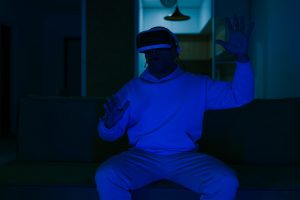Immersive Language Learning: VR for Fluency
As technology continues to advance, virtual reality (VR) has emerged as one of the most innovative tools for learning. Thanks to its immersive and interactive nature, VR has proven to be especially useful in language learning, allowing users to fully immerse themselves in a virtual environment where they can practice and improve their language skills in a realistic setting. In this article, we will explore the concept of immersive language learning and how VR technology is transforming it, specifically in regards to fluency. So, let’s dive into the world of VR and its role in language fluency.
The Power of Immersive Language Learning
Traditional language learning methods often involve repetitive exercises and lessons, which can be tedious and boring for learners. This can lead to a lack of motivation and hinder the learning process. On the other hand, immersive language learning through VR provides a more engaging and interactive experience, making the learning process more enjoyable and effective.
Realistic Environments for Practice
In traditional language learning, learners usually practice their skills in a classroom setting, which may not always reflect real-life situations. However, with VR, learners can enter a 3D environment and have a more realistic experience of using the language in everyday scenarios. For example, a VR language learning app may simulate a trip to a foreign country, where learners can order food in a restaurant or have a conversation with a local, making the learning experience more authentic. This type of immersive practice can greatly improve fluency by building confidence and familiarity with the language.
Interactive Conversations with Virtual Characters
In VR, learners have the opportunity to engage in conversations with virtual characters in a safe and controlled environment. This allows them to practice their speaking and comprehension skills without the fear of making mistakes in front of others. Additionally, these virtual characters can be programmed to respond differently based on the learner’s level, providing a personalized learning experience. This feature of VR not only enhances fluency but also promotes the development of conversational skills.
The Role of VR in Improving Fluency
Fluency is the ability to speak a language with ease and confidence. It requires a combination of a wide range of vocabulary, proper grammar, and the ability to speak smoothly without pauses or hesitation. While traditional methods of language learning may address these aspects separately, VR can effectively combine all these elements to improve fluency.
Vocabulary Building
In VR language learning, vocabulary is often taught through immersive activities and games. These interactive exercises can help learners quickly acquire new words and phrases while also improving retention. For example, in a VR environment, learners may be asked to interact with different objects and label them in the target language, making the learning process more engaging and fun. This type of activity can greatly enhance vocabulary retention and expand the learner’s overall knowledge of the language.
Grammar Practice
In addition to vocabulary, VR can also help learners practice grammar in a more natural and practical way. In a VR environment, learners are often presented with real-life situations where they have to use proper grammar to communicate effectively. By constantly using grammar rules in these simulated scenarios, learners can internalize the language and improve their fluency in a more organic way.
Pronunciation and Intonation
Pronunciation and intonation are essential elements of language fluency. VR technology offers advanced speech recognition capabilities that can help learners improve their pronunciation by providing instant feedback. This feature allows learners to listen to their own speech and make adjustments to improve their accent and intonation. By consistently practicing in a VR environment, learners can perfect their pronunciation and speak the language more fluently.
Conclusion
In today’s globalized world, fluency in a second language is becoming increasingly important. With the help of VR technology, learners can now improve their fluency in a more engaging, practical, and effective way. From realistic environments to interactive conversations with virtual characters, VR offers a unique learning experience that combines all aspects of language learning to help users become more fluent speakers. So, if you’re looking to take your language skills to the next level, immerse yourself in the world of VR and see the difference it can make in your fluency!






